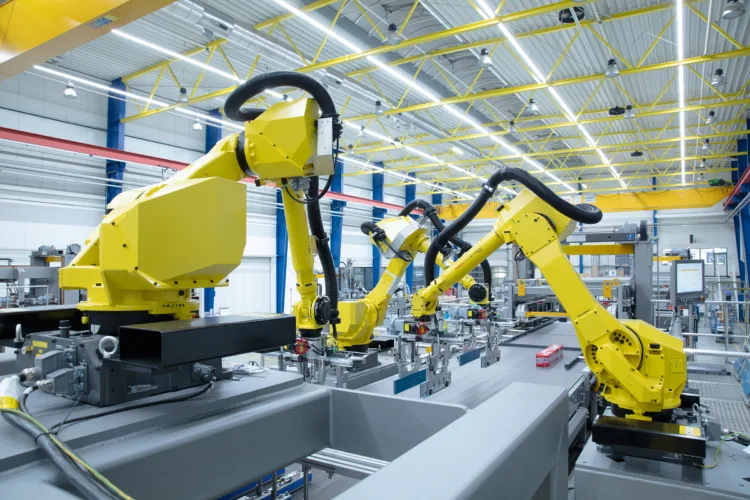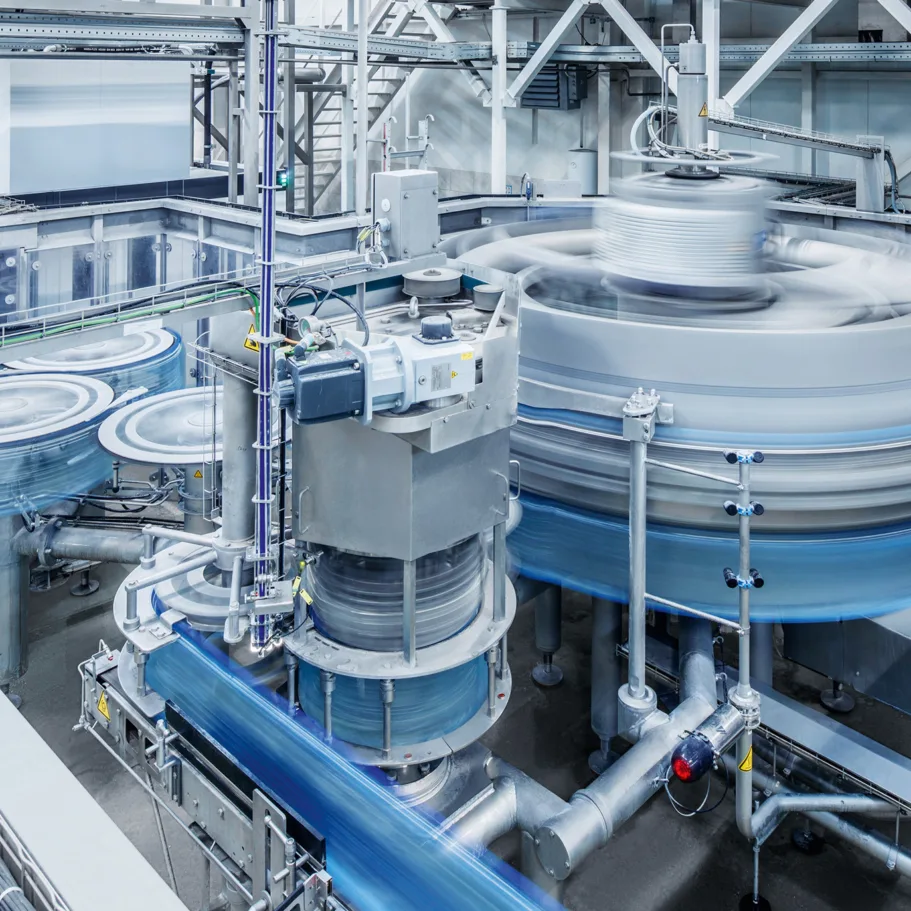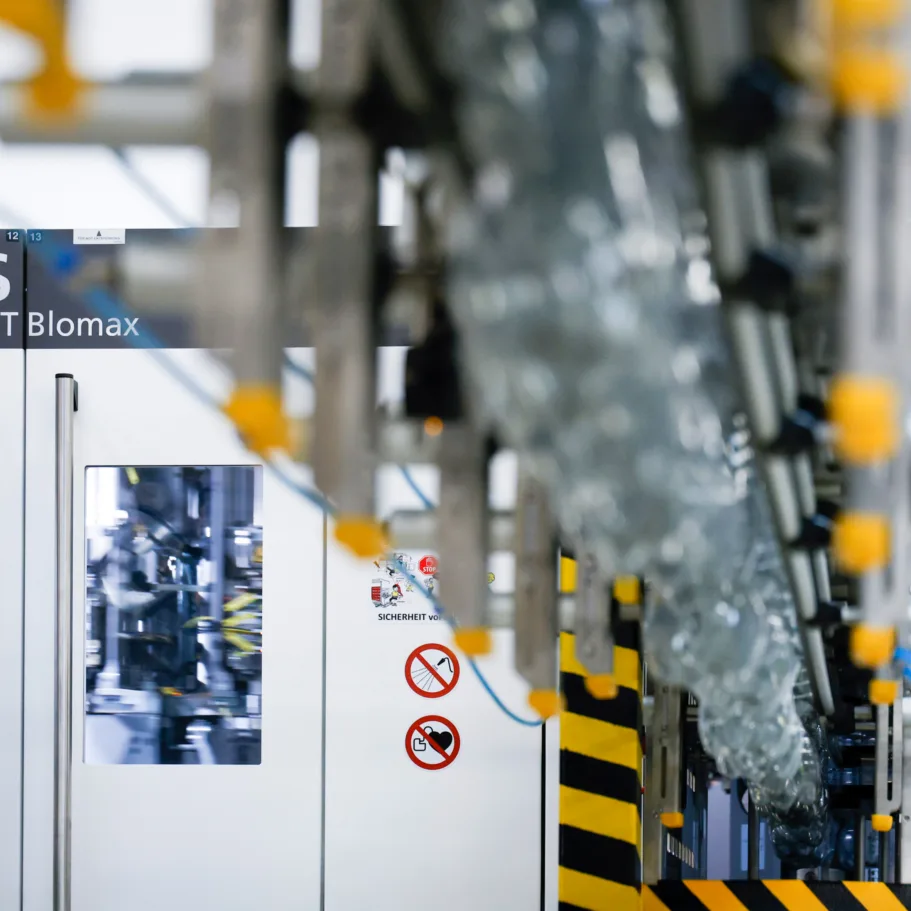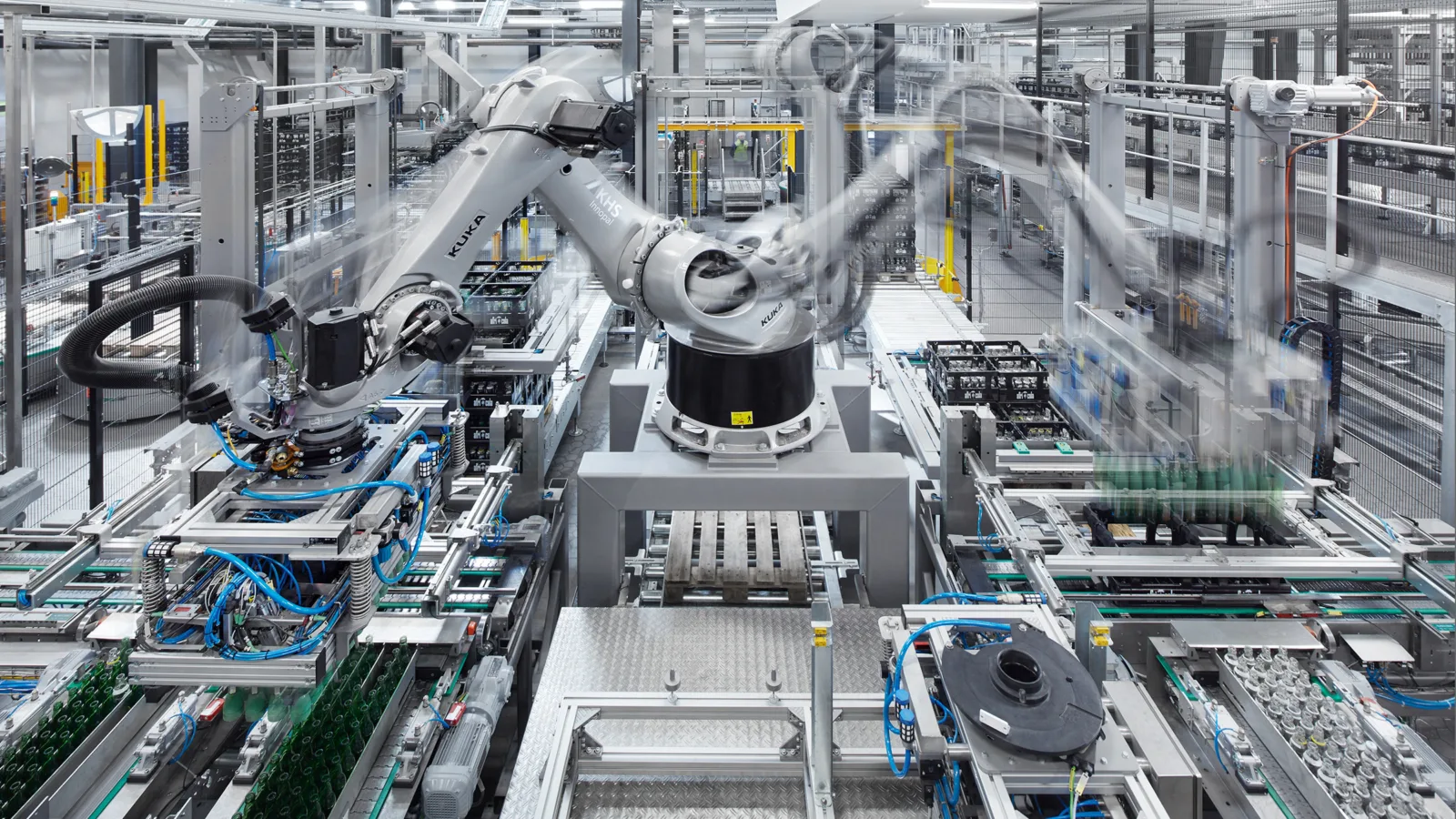
Colleague robot
KHS has been using robots successfully for 25 years, especially in the packaging and palletizing sections of its lines. These high-tech systems master tasks such as sorting, distributing, depalletizing, palletizing and stacking efficiently, flexibly and economically – here, a summary.
The use of robots in the packaging and palletizing process steps is on the increase both in KHS’ single machine business and in its line projects. They’re considered to be extremely reliable and low maintenance and provide secure production. They often perform several tasks at the same time and are valued as a future-proof investment. Any company that has procured a robot knows that this highly flexible technology has an extremely long service life: all that is required when setting up new functions is to replace the specific tool and modify the programming. What’s more, these intelligent machines produce at a low cost and are much easier to operate than some people think. It’s thus no surprise to learn that a growing number of bottlers in the beverage industry wish to make greater use of ‘colleague robot’.
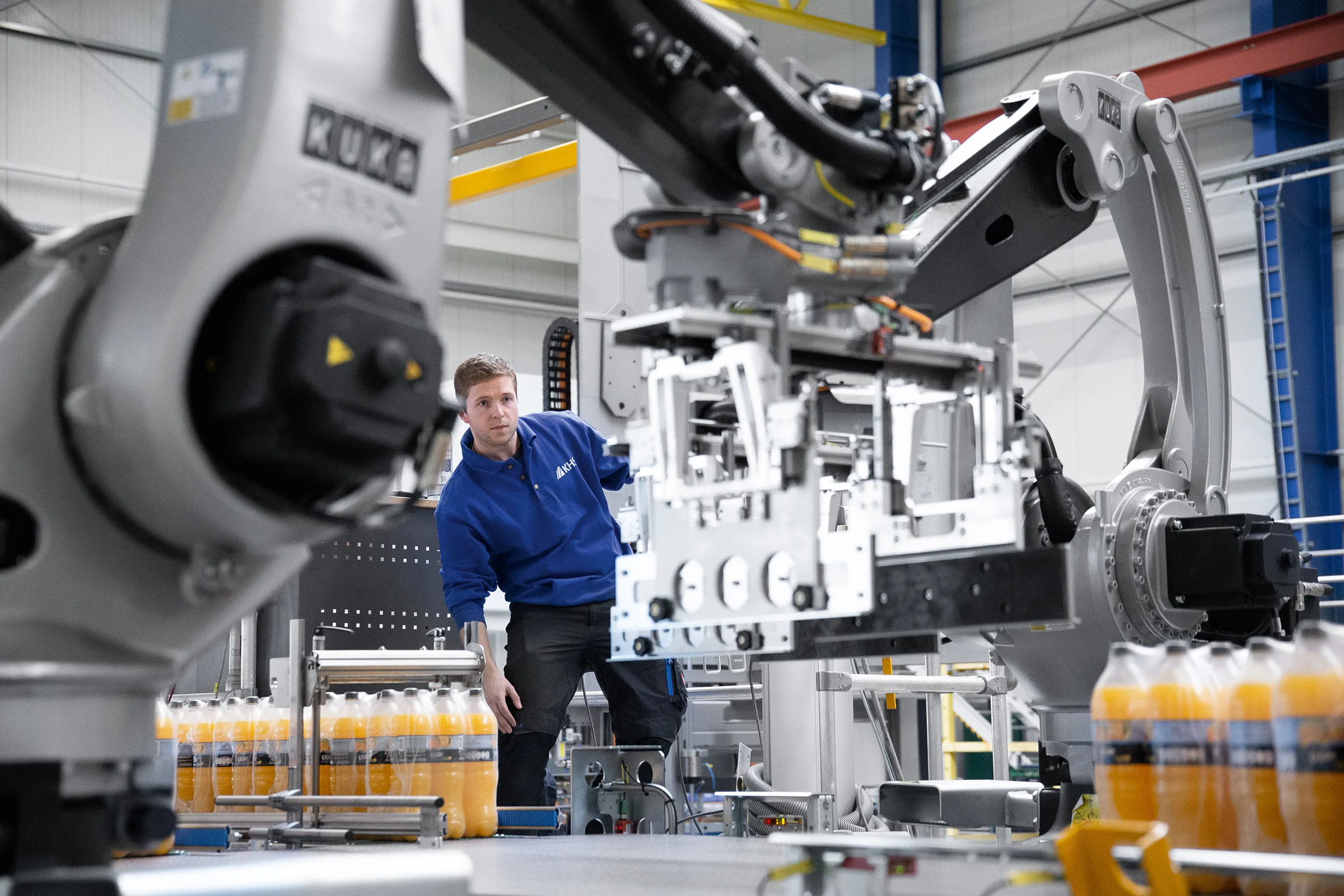
Packs of six non-returnable PET bottles prior to gentle but precise pickup by the clamping jaws: two grouping robots wait for the KHS commissioning engineer to give them the go-ahead.
Many years of experience
KHS has been successfully using robot technology on its production lines for over 25 years. The Dortmund systems supplier thus has a wealth of experience and expertise in this field of application.
The first projects were implemented in the palletizing section for customers in Gerolstein and Regensburg back in 1996. As the maximum weight that could be processed by the robots then in use was subject to certain restrictions, to start with they weren’t used to palletize full layers. Initially, typical applications included palletizing and depalletizing, packing and unpacking of returnable crates and keg palletizing. At the beginning of the 2000s systems started to come into use built by KUKA, a specialist for automation based in Augsburg and active the world over. Its robots were able to manage greater weights and used the same machine control system found in KHS equipment at that time. Some customers in the beverage industry prefer robots manufactured by FANUC; KHS works with these, too. “If someone’s already using a system, they don’t want to switch to another one. It’s almost a question of religion,” says Christoph Wiesenack, palletizing product manager in Worms.
Since KHS has extensive knowledge of the systems made by both manufacturers, Wiesenack and his colleagues believe it’s a matter of secondary concern as to which one they work with. “However good the robots are, they’re only brought to life when used properly,” he emphasizes. This is where KHS comes into play. “Based on our experience we know where and for which functions robots can be constructively used. Our concrete tasks are programming and the manufacture and configuration of tools and peripherals – from pallet conveyors through grouping and unloading tables to centering. This is where our expertise lies.”
»With our experience we know where and for which functions robots can be constructively used.«

Palletizing product manager, KHS
Robot grouping
Robots were first used for grouping in 2004, a process in which packs are formed into layers. “This application is our bread and butter, so to speak,” smiles Wiesenack. Since the beginning the team in Worms has continued to develop its robotics, particularly the robot heads. “These are the tools at the end of the robot arms that come into direct contact with bottles, cans, packs, cartons or crates. Hardly anyone knows better than we do what has to be taken into account for products to be processed flawlessly. This is why we engineer these product-contacting parts ourselves.” Special functions integrated into the heads include crash protection, for instance, that prevents packs and machines from damage. There’s also a compensation system that reduces wear and abrasion and an extremely simple clamping jaw changeover. The packs to be grouped are gripped by the servo-motorized jaws and pushed into the required position. “We set the clamping pressure to a defined value with the help of the motor’s power input and can thus grip and process products very gently – even sensitive packs such as our new paper pack,” Wiesenack states.
Robot grouping at KHS is now largely standardized – both with respect to the table, its position and the programming. Variants have one to three robots and are available with one to four infeed lanes. “Our product center is experienced in this without us having to clarify much more here,” says Wiesenack. Accordingly, the number of grouping robots installed to date is high and currently amounts to about 600, with 50 new ones added each year.
Besides grouping, today KHS also uses robots to palletize non-returnable packs and for other applications such as sorting and distribution. Robots are used in keg processing to unload and palletize kegs, for instance. Image processing systems enable further functions to be incorporated, such as keg turning on demand, fitting position detection, identification of the layer pattern on the pallet and adjustment of the process steps to suit the current kegging situation. Automatic tool changeovers can also be provided as an option for most robot applications and retrofitted on request.
At a glance
Use of robots at KHS
Manipulation during pack conveying: distributing and combining
Grouping: pack turning and positioning
Crate magazine: stacking and unstacking of empty crates on returnable lines
Packing: packing and unpacking of containers
Material handling: layer pads, top frames, pallets and kegs
Palletizing and depalletizing: returnable and non-returnable containers and kegs
Loading and sorting functions
KHS’ expertise is particularly important when special functions are required that standard machines can’t perform, for example during loading or sorting. One example of this is in operation at RHODIUS Mineralquellen in Burgbrohl, where segregated bottles and crates are packed and palletized according to type by one machine. Here, the robot picks segregated crates of returnables comprising mainly foreign bottles from the line and places them on pallets for removal from the line. It also packs segregated empty bottles into empty crates and places them by type according to a set pattern back onto pallets that are then ready for discharge. During production the system thus generates sorted empties for later processing more or less as a by-product. Flexible adaptation to the sorting rate means that functions can be assigned as required during the shift.
One very different special application has been developed in the course of KHS’ cooperation with one of the world’s leading soft drinks producers. Over the past five years several robot applications have been installed here for the preparation of basic soft drinks components required at the company’s various production sites to mix its finished beverages. In this example, too, the team of experts from KHS has developed a number of line-specific palletizing systems. The future viability of the systems has also proved itself here; following the move to a new facility, by decoupling certain functions and through rearrangement of the palletizing section a palletizing robot already supplied was assigned two more lines for palletizing, increasing the palletizing capacity in the process. The customer is extremely satisfied with the results.
Where is our expertise in palletizing demonstrated? In our Innopal RK articulated robot, for example. Read more on khs.com.
Fewer tasks, greater performance
It goes without saying that even robots have their limits. “It’s like with people; they too can only perform a certain number of tasks within a given time. The more functions we include on a machine, the lower the output in containers per hour.” If groupings process up to 144,000 cans per hour, for example, combined palletizing cells in the lower or medium capacity range are used. The output here depends on the number of functions to be carried out, such as picking up and placing packs onto pallets, forming layers and processing layer pads and empty pallets. The palletizing cell permits complete, fully automatic palletizing including pallet liner and layer pad handing within a relatively small space of just 35 square meters.
Future standardization
In the future Wiesenack also wants to make loading stations as uniform as possible so as to be able to offer standardized systems as for grouping that enable faster lead times and incur less cost. “Our palletizing cell for the low capacity range is a first step in this direction,” he tells us. “We can imagine that we’ll achieve higher outputs on standardized systems in the future because the focus is solely on palletizing; we can then get the most out of the robot here. On customized systems, where the accent is on flexibility rather than just palletizing, we’re bound by the layout and specified tasks.” The specialists in Worms are also planning to extend virtual commissioning and rely more heavily on the digital twin in order to exploit further potential for increasing efficiency.
Synergies are to be used for this purpose: since robots are usually equipped with a digital environment by their manufacturers, KHS can also commission them virtually. All it then has to do is integrate its tools into the existing environment.
